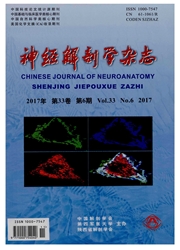

 中文摘要:
中文摘要:
目的:探讨糖尿病高血糖状态对于大鼠海马星形胶质细胞的影响。方法:应用链脲佐菌素(STZ)诱导I型糖尿病SD大鼠模型,分为糖尿病模型1、2、3、4周和5周组(DM1,DM2,DM3,DM4,DM5),同周龄sD大鼠作为对照组。采用免疫荧光、免疫组化和Western Blot等技术,对比观察糖尿病大鼠海马区星形胶质细胞的形态、caspase一3和GFAP的表达情况。结果:免疫荧光和免疫组化检测结果显示:DM1和DM2大鼠海马区星形胶质细胞的胞体增大,突起增粗;DM3和DM4大鼠海马内星形胶质细胞的突起增粗、变长,其数量明显多于正常对照组(P〈0.05);而DM5大鼠海马内星形胶质细胞的突起僵硬,细胞数量有所减少,但仍高于正常对照组(P〈0.05)。WesternBlot结果显示:DM3,DM4,DM5大鼠海马区GFAP含量明显高于对照组和DM1,DM2(P〈0.05)。caspase-3/GFAP免疫组化双标结果显示:DM1和DM2大鼠海马区偶见caspase-3阳性标记的星形胶质细胞;而DM3,DM4,DM5大鼠海马区caspase-3/GFAP双标细胞数明显多于正常对照组(P〈0.05);其中DM5双标阳性细胞数明显多于DM3和DM4(P〈0.05)。结论:糖尿病高血糖早期可激活星形胶质细胞,持续性糖尿病高血糖可诱导海马区星形胶质细胞活化的抑制,并引起星形胶质细胞凋亡。
 英文摘要:
英文摘要:
Objective: To investigate the effects on the hippocampal astrocytes of diabetic hyperglycemia. Methods: Type 1 diabetes mellitus rat model was induced by injection of streptozotocin (STZ). The activation and apoptosis of astroeytes and the expression of caspase-3, GFAP immunoreactivity in the hippocampus were comparatively observed by immunofluorescenee, immunohistochemistry and Western Blot at 1-, 2-, 3-, 4- and 5-week of diabetic model ( DM1, DM2, DM3, DM4 and DM5 in abbreviation, respectively). Results: As immunofluorescence and immunohistochemistry shown, enlarged cell body and process of astrocytes were demonstrated in the hippocampus at DM1 and DM2, lengthening and thicken process at DM3 and DM4, inelastic process at DM5. The numbers of GFAP- immunoreactive astrocytes in the hippocampus at DM3, DM4 and DM5 were significantly increased compared with control, DM1, and DM2 rats (P 〈 0.05 ). Western Blot resalts showed, that the contents of GFAP in the brain at DM3, DM4 and DM5 were significantly up-regulated compared with control, DM1, and DM2 rats ( P 〈 O. 05 ). It could be seen from double labeling of cleaved caspase-3 and GFAP, rare cleaved caspase-3 labeled astrocytes in the hippocampus at DM1 and DM2. The numbers of cleaved caspase-3 labeled astrocytes in the hippoeampus at DM3, DM4 and DM5 were significantly increased compared with control, DM1, and DM2 rats (P 〈 0.05 ). Compared with DM3 and DM4, the numbers of cleaved caspase-3 labeled astrocytes at DM5 were farther increased (P 〈 0.05 ). Conclusion: The activation of astrocytes induced by diabetic hyperglycemia was occurred at early stages. However, persist diabetic hyperglycemia can induce the inhibition of astrogliosis and lead to astrocytes apoptosis.
 同期刊论文项目
同期刊论文项目
 同项目期刊论文
同项目期刊论文
 期刊信息
期刊信息
